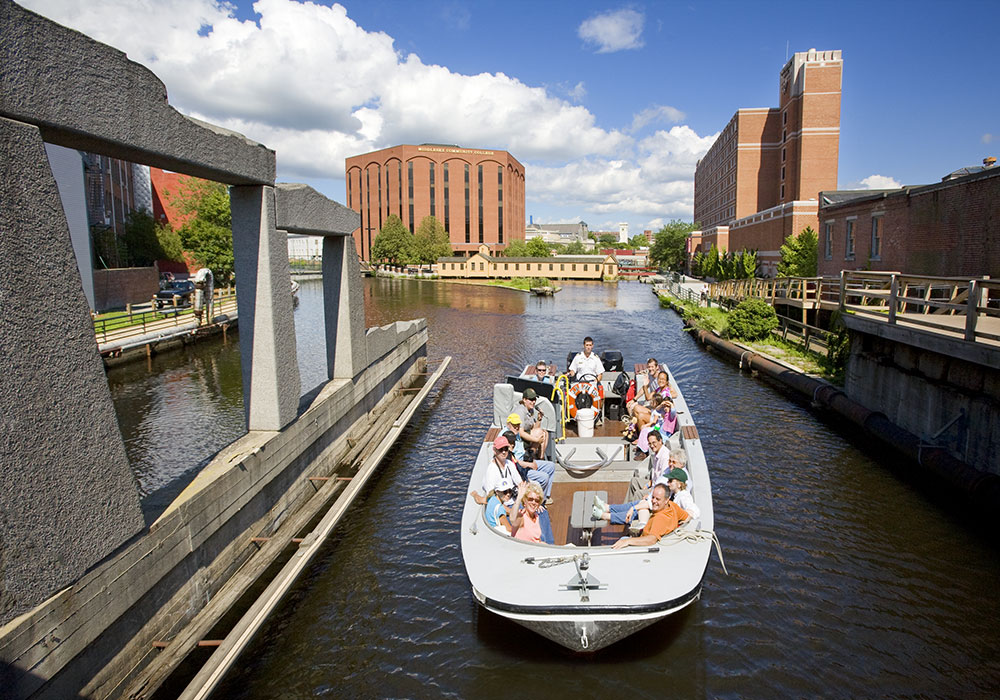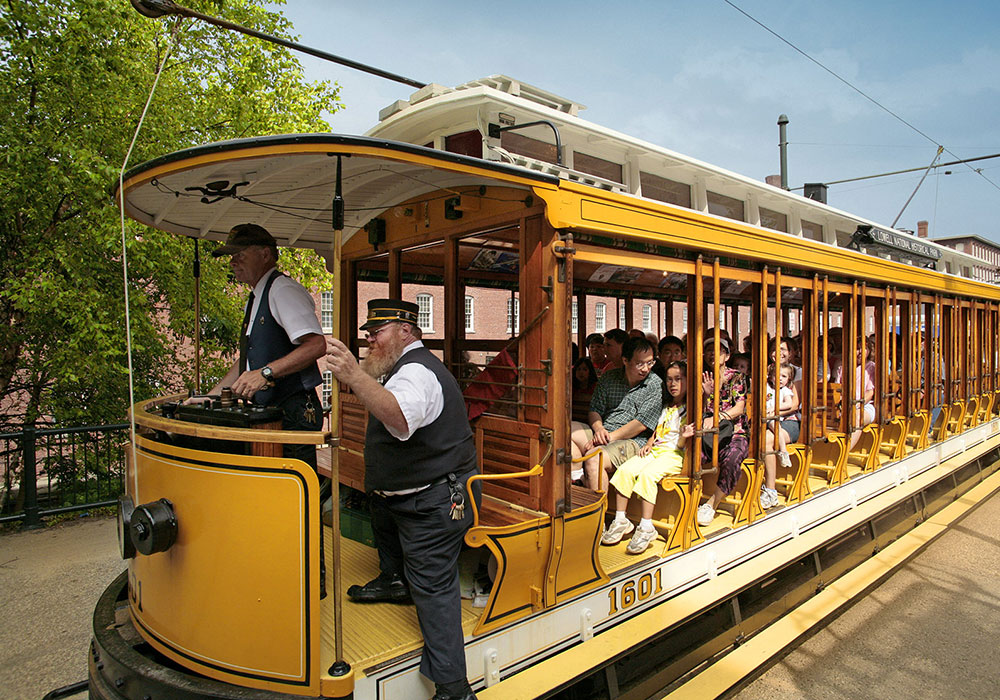Canalway Cultural District: Lowell, Massachusetts
Planning Excellence
Lowell has evolved from the nation’s largest industrial center to one of the most exciting cultural centers in Massachusetts, one of 44 cultural districts in the state. Lowell’s Canalway Cultural District is defined by a thriving arts community, daily cultural activities, and an array of dining and shopping destinations. Through partnerships between the city and private developers, the district’s revitalization has resulted in the creation of over 80 new jobs and a total investment of over $4 million. Lowell continues to value its rich natural and cultural treasures, honoring its past while looking ahead towards a more sustainable future.

Lowell National Historical Park offers tours of the city by boats that travel along the canalways throughout the Cultural District. Photo courtesy City of Lowell.
Community plans, such as the Lowell Downtown Evolution Plan and the Sustainable Lowell 2025 Master Plan, inspired projects and initiatives that have helped the Canalway Cultural District become what it is today. The City of Lowell has used city, state, and federal funding, including Community Development Block Grant (CDBG) funds, to implement improvements that made the downtown safer, more pedestrian friendly, and attractive.
Streets were resurfaced and painted with bicycle lanes, sidewalks and ADA accessible curb cuts were added, improvements were made to the canal and river walkway, and wayfinding signage was added to increase accessibility for people walking and riding bikes. These projects restructured the way that people move around town, enhanced safety, and increased access to businesses, cultural facilities, and historic sites.
Since the 1970s, Lowell has seen a remarkable rebirth and revitalization. The designation of the Lowell National Historical Park in 1978 as the nation’s first urban national park, along with complementary local and state efforts to promote historic preservation, heritage tourism, and economic renewal stimulated a restoration of the downtown. An early 1980s wave of immigration, especially from Southeast Asia, Africa, and Latin America, enabled Lowell to carry on its proud tradition of drawing upon the vitality of its immigrant communities.
More recently, through the diversification of its local economy, the city’s job base has broadened beyond its traditional manufacturing core. Emerging technology, education, healthcare, and creative economy sectors have contributed to Lowell’s recent vibrancy and renewed spirit of innovation.

Outdoor restaurant seating in Downtown Lowell’s Canalway Cultural District. Photo courtesy City of Lowell.
Following the recommendation of the Lowell Downtown Evolution Plan, two-way traffic operations were successfully restored to several downtown streets in 2014, increasing accessibility and making retail storefronts more attractive. Community members have been foundational in the work that has gone into designing and revitalizing the 158-acre district. Residents can enjoy free public and private events, performances, and activities. Since 2000, the city has worked with private developers to facilitate the rehabilitation and reoccupancy of over 3 million square feet of vacant downtown buildings. Additionally, over 1,800 residential units have been added to the downtown, representing a total investment of approximately $877 million.
The vibrancy of the neighborhood is seen in its variety of retail, embrace of diverse cultures and the arts, multitude of community events, and 500,000-plus visitors each year. Yet planning and development are ongoing. The district includes a 15-acre area — the Hamilton Canal Innovation District — which will be renovated to create nearly 2 million square feet of new building space, including over 700 new units of housing, up to 55,000 square feet of retail, and up to 450,000 square feet of commercial or office space. The renewed vitality of the neighborhood could not have been realized without the creative and thoughtful planning by the city and residents, and the community looks forward to changes yet to come.
Defining Characteristics and Features
- Lowell has protected canals within the city and has often leveraged them to generate new development or redevelopment. The Merrimack Riverwalk, a $3.5 million walkway along the historic “Mile of Mills” on the Merrimack River, connects the University of Massachusetts at Lowell, LaLacheur Park (the city’s minor league baseball facility), and the Paul E. Tsongas Center with the city’s Central Business District in the Canalway Cultural District.
- Two farmers markets operate in the Canalway Cultural District: one at Lucy Larcom Park and another at Mill No. 5. The Lowell Farmers Market (Lucy Larcom Park) accepts SNAP dollars and provides transportation for seniors from the Lowell Senior Center.
- Historic character has been embraced and enhanced through resetting cobblestone streets, planting trees, hanging planters, installing Victorian-style streetlights, and landscaping around city hall. Millions of square feet of historic mill buildings throughout the district have been adaptively repurposed into residential, office, and mixed-use properties. One example of this in the Canalway Cultural District is the five-acre Western Avenue Studios complex, the largest artist community on the eastern seaboard of the U.S., and home to over 300 artists in 250 work-only studios and 50 live-work lofts.
By the Numbers
- Through the Department of Energy’s “Better Buildings Program,” 500,000 square feet of downtown historic commercial space has been retrofitted for a projected energy savings of 31 percent.
- The Lowell Development and Financial Corporation’s Downtown Venture Fund has financed over 40 new businesses in downtown Lowell, representing an investment of approximately $4.25 million.
Designated Area
Generally encompassing Lowell’s downtown core, the Canalway Cultural District is bounded to the northeast by the Merrimack River, running south along Brown and Howe Streets, then running west along the Concord River and Lower Pawtucket Canal, until hitting Central Street. Bounded by Middlesex street to the south, Thorndike Street and Dummer Street to the west, and then along the Merrimack Canal until returning to the Merrimack River.

Visitors can experience the Downtown Lowell Canalway Cultural District on a free trolley system operated by Lowell National Historical Park. Photo courtesy City of Lowell.
Learn More
Plans
Videos
Other Links
Canalway Cultural District Brochure
Hamilton Canal Innovation District


